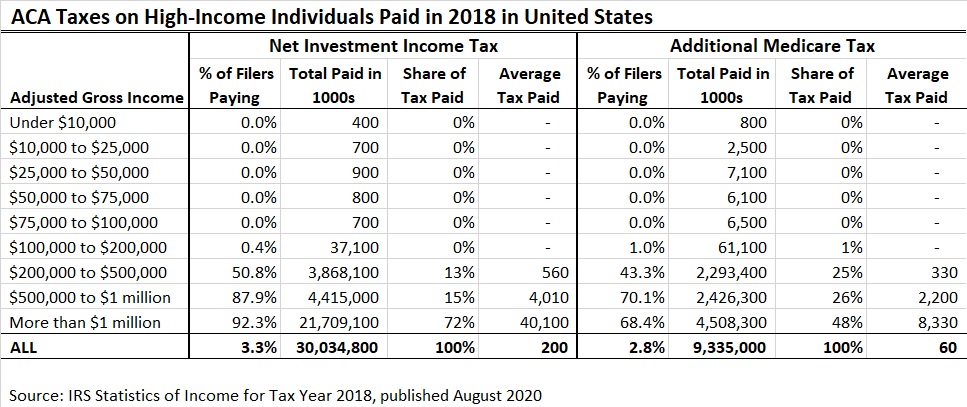Download National and State-by-State Data
If the Supreme Court strikes down the Affordable Care Act (ACA), as argued for by the Trump administration and the president’s nominee to the court, Amy Coney Barrett, one under-appreciated result will be a tax break of roughly $40 billion annually for about 3 percent of Americans, who all have incomes of more than $200,000.
As illustrated in the table below, the IRS’s most recent data show that 3.3 percent of tax filers paid more than $30 billion cumulatively in net investment income tax (NIIT) in 2018, while 2.8 percent of filers paid more than $9 billion in additional Medicare tax, which is a supplemental payroll tax on high earners. Striking down the entire ACA in its entirety would nullify both taxes.
Click to download national and state-by-state estimates.
The share of taxpayers in each state paying the NIIT varied from a low of 1.4 percent in West Virginia to a high of 5.4 percent in Massachusetts (or 7.1 percent in Washington, DC, if it is counted as a state).
The share of taxpayers in each state paying the additional Medicare tax varied from a low of 1 percent in Mississippi to a high of 5.2 percent in New Jersey (7.1 percent in Washington, DC).
Background
Barrett authored a journal article suggesting that the Affordable Care Act (ACA) is unconstitutional. If confirmed, she will replace Justice Ruth Bader Ginsburg, who was part of the 5-4 majority that upheld the ACA when its constitutionality was challenged in 2012. The court is scheduled to hear another challenge to the ACA on Nov. 10.
Striking down the ACA would not only eliminate health coverage for millions of people, it would also have another consequence that is rarely discussed openly by opponents of the law. If the court throws out the ACA entirely, that would nullify two tax increases on high-income individuals that were enacted as part of the ACA to help offset the costs of increased coverage.
Before the ACA, working people all paid 2.9 percent of their earnings to fund Medicare. This tax was never very progressive given its flat rate and the fact that it exempts investment income that disproportionately flows to the rich.
The two high-income tax increases in the ACA address those problems. The additional Medicare tax is an additional 0.9 percent tax on earnings over $200,000 for unmarried workers and $250,000 for married workers. This effectively means that high earners pay a top rate of 3.8 percent on their earnings above those levels.
The net investment income tax (NIIT) is a 3.8 percent tax on investment income (capital gains, dividends, and interest and other investment income). This tax only applies when investment income causes a taxpayer’s income to exceed $200,000 for unmarried individuals and $250,000 for married couples.
The result of these provisions is that most income, whether it comes from work or investments, above a high threshold is subject to a tax of 3.8 percent to help fund health care. As illustrated in the table above, more than 70 percent of the NIIT was paid by those with adjusted gross income (AGI) exceeding $1 million and more than 70 percent of the additional Medicare tax was paid by those with AGI exceeding $500,000.
If the Supreme Court strikes down the Affordable Care Act, the losers will be the tens of millions of people whose health insurance disappears. The winners will be a tiny handful of very well-off individuals who receive yet another tax cut thanks to the Trump administration.






